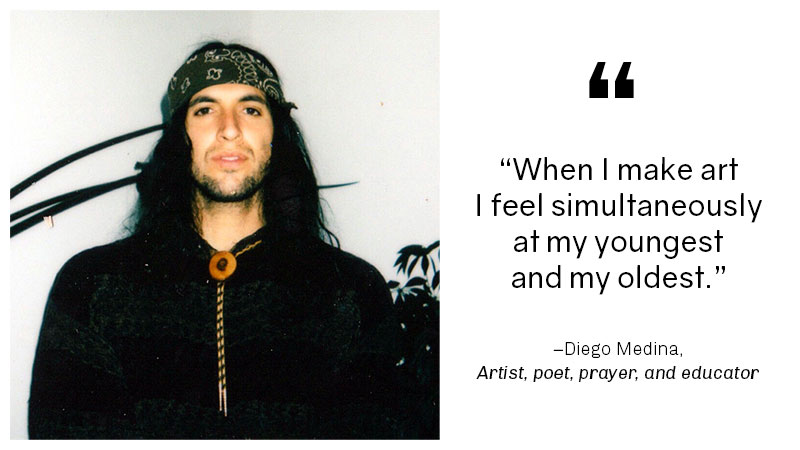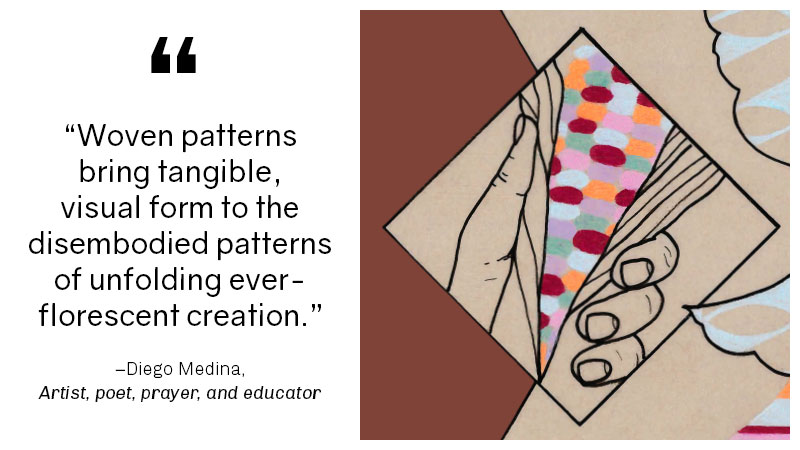At oVertone, we are dedicated to using our platform and privilege within the beauty industry to advocate for marginalized communities. Some of the most marginalized communities throughout history are America’s own Indigenous tribes. That’s why we take the opportunity to donate to the Native American Rights Fund annually, which advocates for Native rights and preservation of tribal histories. This month, we’re also celebrating Native American heritage by spotlighting Indigenous artists.
We couldn’t be more honored to work with Diego Medina, who created a phenomenally moving piece of art for our November poster. Diego Medina is an Indigenous artist, poet, prayer, and educator from Las Cruces, New Mexico. His family is one of the original Piro-Manso-Tiwa families from the historic Mesquite district.
Continue reading to learn more about Diego and what his artwork represents for both him and his community.

Name: Diego Medina
Current Location: Nambe, New Mexico
What inspired you to become an artist? When did you first start creating art?
I think it’s a very old relationship. I have been making art, and experiencing synaesthesia (which prompted expression) for as long as I can remember. I have two ancestors who were artists (that i know of): my great grandfather and my grandmother. and I see them as carriers of that breath I reference. I am so proud of them and grateful for them. My grandmother used to draw with me all the time when I was young. We would just sit and draw for hours, and I really must credit her for giving me the space to articulate my expression visually and for being the first artist I knew and looked up to. She was the first to bring that breath to me.
And since then I have been committed to that sacred relationship. I love the word “inspire” and how it invokes this sense of breath or breathing, because that is how we acknowledge blessing. Breathing is this sacred chain we have with all life and to be inspired is to be connected in blessing, to divine source, through living (through breathing). The source which inspires me is the source that breathed life into its enterprise of divine will. And choosing to align with that ancient holy intention is a special sanctity; a very loving relationship with yourself and that which has made you yourself.
When I make art, I feel simultaneously at my youngest and my oldest, and I think that’s significant. It shows how there is this temporal lemniscate of which we are passengers on the train figure-eighting through that course, experiencing and witnessing what is ancient in us and what is yet undiscovered. True inspiration is when that is reconciled. When the past and the future meet for a romance inside of you; meet to breathe together.

What does November’s poster artwork represent to you? How does it represent Native American Heritage Month?
Braiding hair is like weaving to me in that they both bring things together, using active geometry, to create patterns that reflect what is inherently divine, both in us and within the entire universe. woven patterns bring tangible, visual form to the disembodied patterns of unfolding ever-fluorescent creation. And braiding is a way of taking our hair, a literal extension of ourselves and our senses, and styling it in a manner that organizes it similar to an act of prayer. Braiding hair is a very ancient way of activating prayer in the physical body. In this artwork, I wanted to tie it together (braid together?) these two symbols that speak to this prayerful relationship.
Then I tied in the metaphor of corn, being a symbol of life and cultural prosperity, and visually linking it to the act of braiding to show how these divine reflections are mirrored in other aspects of culture and sacred lifeways. Corn is also a braided thing, a woven thing, and it’s one that nature does on its own, and it reminds us that we too are nature constantly in reflection of the divine, so long as we move in a place of prayerful conscious will. Putting all of this into this image is how I want to represent Native American Heritage Month because it shows the depth of beauty, intelligence, and divine intention Indigenous people carry, and have carried.
I not only wanted to engage traditional imagery, but also show how this relationship through imagery is a contemporary reality and a future obligation. I also love fairies and I wanted to draw a cute fairy to reclaim spaces of cuteness that aren’t always afforded to Indigenous people, or Black people, or undocumented people, or people with different abilities, or queer people, and so on. Magic and wholesomeness are indigenous qualities. And a re-indigenized world will be one wherein magic brings forth the redemption of the earth and cute wholesomeness is a community value.

What else do you want people to know about Native American Heritage Month?
As we all know, indigeneity in all its beauty can’t be shrunk down and subsumed into one month. I want people to use this month to dream of indigenous futures as much as they honor the indigenous past. Because indigeneity is infinite, and indigenous culture isn’t something of the past. It is the true way of living in balance with the earth and in accordance to divine intention and that is something that will be a forever thing. So don’t let the word “heritage” make you think this is just about the past. Indigeneity is as much future as it is present as it is past.
How do you represent yourself and your community through your work?
Community is an interesting word to me because it can be very arbitrary for some people. The community can also be very human-centric and so I often replace community with ecology. How are we living cooperatively with all relatives, not just the human ones. My work involves a lot of prayer and spiritual map-making to elucidate complex understandings of interrelation and reciprocity and sacred balance. This is how I represent myself. I represent my process of gnosis in regards to these matters and I illustrate my spiritual beliefs and commitments that are informed by ancestral wisdom and personal practice of prayer.
Along with that, I incorporate so much history specific to where my people come from and this is how I represent my community. I really look closely at histories and find the overarching numinous mythologies that these histories expand into. I am so passionate about history and specifically about making sure our tribal history is known and accurately told, and that is an equally important part of my work as well. Because to me that ties into holistic ecology in that we are a part of the ecological family from the land we are the original stewards of and our history is climate justice. Or rather, acknowledging our history and subsequently making equitable, informed decisions based on that history and how we lived and live harmoniously with our environment is climate justice.
I want to not only represent my community, but also the divine will of creation that informed our ecological lifeways. The land is also my community. The earth is also my community. and the spiritual forces that guide creation are definitely my community. Beyond that, the Piro-Manso-Tiwa Tribe is a very overlooked tribe and I am dedicated to being a lantern within the historical and political darkness. I’ll make sure people know about the Piro-Manso-Tiwa Tribe. because that is my community.

What role do you feel you have in society and in your community as an artist?
I truly do let prayer guide me, and what I am called to do; I put my entire faith behind it. My role is to live in prayer, and extend into the world in prayer, and show that ceremony and prayer are such important revolutionary acts. Realigning with a life of ceremony is immensely critical, and it is real work. Never underestimate the importance of prayer and ceremony, and this is for my community and society as a whole.
We’re all about hair and individuality, so we have to ask, what role does your hair play in your self-expression?
For as long as I can remember I have had a very sacred, loving relationship with my hair. Along with being an extension of my nervous system and thus an extension of my spirit, my hair is a visual combination of all the stories of my ancestors from all parts of the world. In that regard I like to picture myself as an upside down tree, my hair being the roots that are spiritual extensions of my ancestors at source and that flows through my whole nervous system guiding me. Hair is the organ of intuition—don’t tell a biologist I said that because they aren’t ready for it, but it’s true. Hair is what allows me to be self-expressive because it is part of what guides me through sensation and intuition and prompts expression. It plays a very critical role and I trust my hair as a mentor and a guide in my creative practices.

